
How building a Buyer Persona from our sales data skyrocketed our sales

“Patching together actionable information about your customers with gut feelings, good intentions and some duct tape is not a recipe for conversion success… The problem with many personas is that they are either based on irrelevant data, poorly sourced data, or no data at all.”
What happens when you don’t know your customer?
Having a clear understanding of who your customers are, what motivates them and what problems they need to be solved is the crux of any successful marketing or sales funnel. Misjudge your audience, their motives, likes and dislikes and you stand to lose big, call it the Pepsi effect.
The CEO built the product because he could see the monetary benefits of high performing teams. Question was, why were other CEOs not buying it? We sat down with the sales team and looked back over the last 6 months of sales in the CRM. What emerged was a revelation.
We had been selling to the wrong person.
Sure, our invoices were ultimately signed off on by the CEO, but that was only half the story. Some further investigation revealed that our product just wasn’t high enough on their agenda. While the CEO’s knew employee performance was something they wanted to improve on, they felt they had more pressing issues to manage, like sales for example. In their minds this is why they hired HR people.
It was the HR people who were actually responding to our sales teams. Bingo.
HR knew the problem. But it tended to be companies over 200 employees that allowed a HR team member to focus specifically on this issue. The language used by HR was different too. Instead of being about revenue and company growth, it focused around employee engagement, communication and team management.
They still needed the revenue and growth numbers to be able to sell the solution internally but that was not why they bought. They wanted a tool that helped them do their job more effectively.
We refocused our sales and marketing resources from the CEO and Managing Directors to the Head of HR, or in even bigger companies the Head of Learning and Development. We used their language from past sales conversations and described the product and problem in terms they could relate to.
This was the point when sales really took off.”
— Alan O’Rourke, VP of Growth at OnePageCRM
How well do you really know your customers? Are your marketing and sales teams aligned in their understanding of a high-value lead versus a low-value prospect?
If the answers to these questions aren’t at the top of your mind, it’s time to re-evaluate your company’s buyer persona.
What is a Buyer Persona?
Most of us will have heard of the term, ‘buyer persona’, in some context or another. But just as a refresher, Adele Revella, founder of the Buyer Persona Institute describes it as:
Buyer persona, also known as customer persona, are fictional representation of your ideal customers. Buyer personas are compiled based on real-life company data relating to customer demographics, lifecycle and buyer behaviour.
Why are customer personas important?
Having a clear understanding of who your customers are, is essential for business success. By adopting a buyer persona your team can:
- Develop a deeper understanding of who your customers are, what their pains are and how to satisfy them.
- Prioritize projects and features based on persona requirements.
- Tailor campaigns and offers to a specific persona.
- Combine the marketing and sale silos into a single customer-centric funnel.
“65% of companies that revised their personas within the last six months beat out the competition when it came to exceeding revenue and sales goals.”
What are data-driven buyer personas?
Buyer personas will only function when built with real-life data. At the core of every persona should be the high-converting, loyal customer that you want to attract more of.
To build a data-driven buyer persona, begin by identifying and analyzing the behaviour of your most valued customer.
Analyze your most valued customer to identify:
- Goals & pain points – What are your customers’ goals? What are they looking to accomplish by using your product/service? What was the selection process in choosing your solution?
- Obstacles to purchase – What are your major customer pain points? What stopped them from making the purchase in the past?
- Expectations & requirements – Are your customers’ expectations and requirements being met? How?
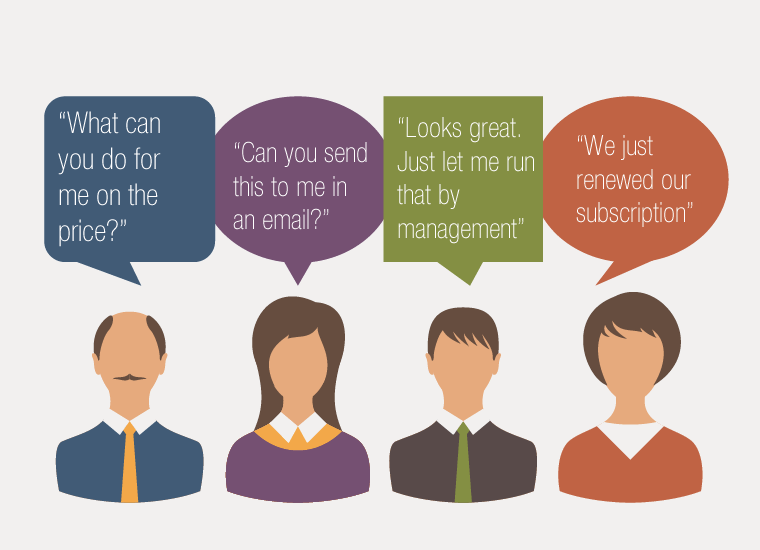
How to build your buyer persona
In order to build a functional and accurate buyer persona, you need to compile and review multiple sources of data.
Start simple, by talking with your sales and support teams who are dealing with leads and customers on a daily basis. They will be able to provide unique insights into what should be included in the company’s buyer persona.

Before putting any templates in place, meet with your sales and support teams and run through the following questions:
- How do you identify a high-value lead?
- What customer pains does our product solve?
- Does our product meet expectations?
- Is there a difference in support/onboarding requirements based on role?
- Who do you see as our primary customer base?
- What are the major obstacles to purchase for buyers?
Once you’re satisfied you’ve gleaned all the insights available from your team, here are some additional ways to build on your persona:
1. Research and interview current customers
It is imperative that you have a clear understanding of who your high-value customers are before delving into the persona development process. Research your customers via LinkedIn and highlight commonalities across job titles, career progression, etc.
Conducting interviews with current and past customers is a sure-fire way of identifying your product’s major wins and pain points. If you’re fortunate enough to get a customer on the phone, use the time to gather as much insight as you can into their buying process:
- What were their barriers to purchase?
- Have their expectations been met?
- What problems does your product solve for them?
- What factors influenced their decision to buy?
2. Add discovery questions to your web forms & exit surveys
Adding persona-specific questions to existing forms throughout your website is a simple and effective way to collect data for optimizing your buyer persona.

When a new trial user signs up to OnePageCRM, we ask a series of discovery questions in order to understand what problems a prospect is looking to solve by using our application.
The insights and data recovered at this stage formulate our buyer persona and act as the basis for feature development and optimization of the app.
Add probing questions to your web forms to gain a better insight into your prospects:
- What size is your company?
- What is your role within the company?
- Where did you hear about us?
- What problem are you looking to solve?
Add an exit pop-up to your homepage and feature pages to identify obstacles to purchase.
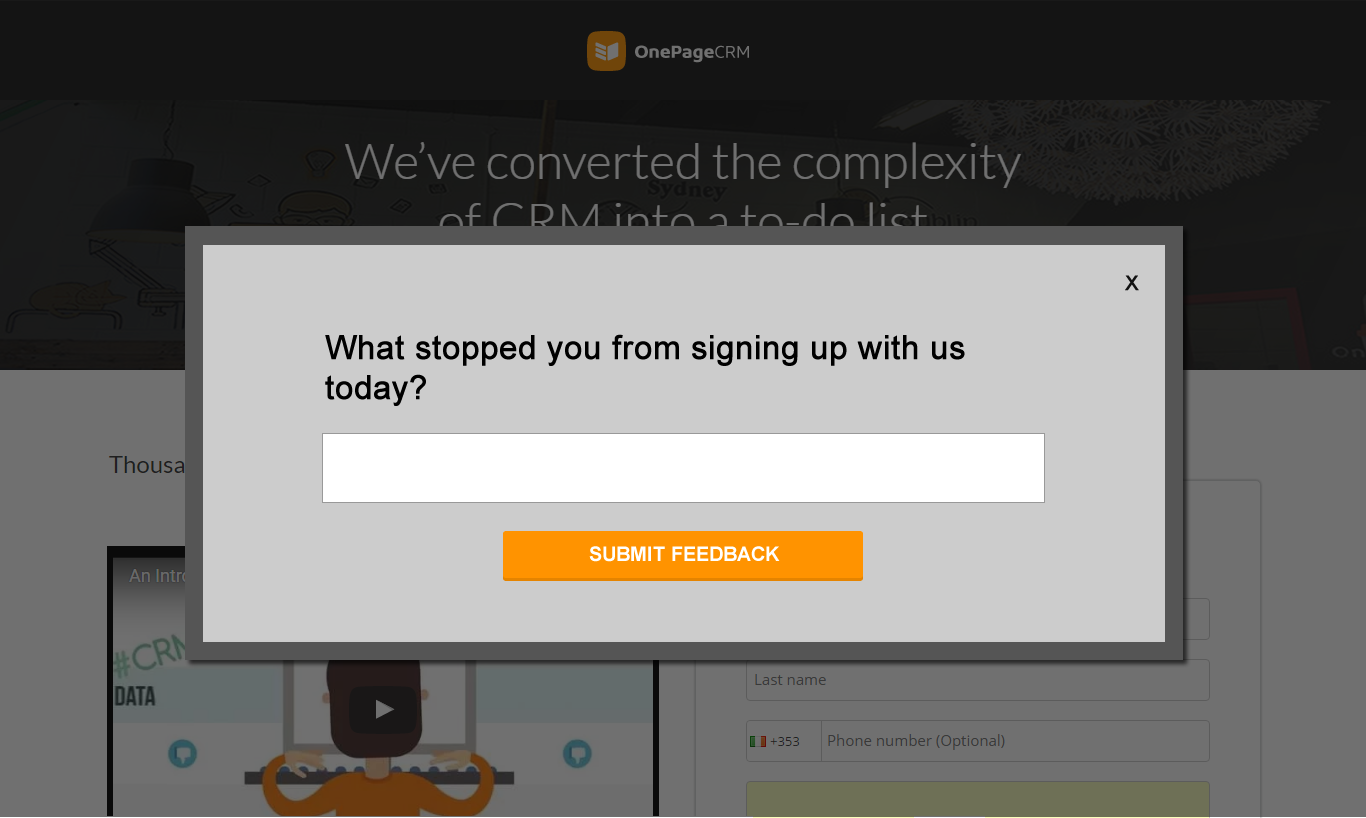
3. Review behavioural trends in your CRM
Your CRM is your data bank for all your customers’ activity. If you and your sales team have been utilizing it correctly, it will contain all the data you could ever need for sculpting killer buyer personas. We’ll show you how to take advantage of this data a little further on.
Buyer persona: The 4 biggest pitfalls and how to avoid them
In order for your buyer personas to be effective, they need to add value, be specific and integrate seamlessly into funnel strategy.
1. Developing  too many personas
too many personas
The most common pitfall when creating buyer personas is simply creating too many.
It’s easy to fall into the trap of creating personas for every characteristic you’ve identified while sifting through your CRM. We’ve all fallen victim to it at one point or another, allowing our enthusiasm for a project to get the better of us.
You need to resist this urge as it will only make the adoption process more difficult for you and your sales team. Remember that personas are a reflection of the common goals of your most valued customers, start with one and build from there.
2. Getting sidetracked by irrelevant data
The fact that one of your customers owns an animal cafe in Brooklyn, is fantastic, I know, but how relevant is this to your overall sales and marketing strategy? Avoid adding trivial nuances to your persona. It will only serve to undermine the validity of the real data and may deter company-wide adoption.
With that being said, adding a name and image to your persona will help humanize the data, full permission to get creative here. Just check out Mailchimp’s versions below:

3. Filling the gaps with assumptions
As a general rule, if you do not have enough data to satisfy a persona, remove it completely. Adding data based on assumptions will affect the credibility of your persona. You want to be able to stand behind your personas when it comes to assigning the marketing budget for the next quarter.
4. Leading interviews with scripted questions
Try and interview a good mix of past and present customers so that you get an unbiased, realistic and rounded viewpoint. The goal here is to identify where your product works and where it doesn’t.
What are negative buyer personas?

If your buyer persona is the profile of the kind of customers you want to attract to your business, your ‘negative’ personas are the direct opposite.
Your negative persona is a fictional rendition of the type of person you want to avoid targeting as they have proven not to be a good fit for your business in the past.
There are a variety of reasons why you may wish to disqualify certain leads:
- Their budget is too small for your product offering
- They are students, who are only engaging with your content to broaden their industry understanding.
- The functionality they require may be too advanced for what you’re offering.
- The cost of acquisition would exceed your sale price.
- They are currently subscribed to a competitor and are not interested in changing providers.
- The ‘tyre kickers’, the tech enthusiasts who are only looking to check out the latest product to market.
Why do buyer personas fail?
You’ve done it…You’ve researched, evaluated, designed and executed your company’s buyer persona.
You’re getting claps on the back from colleagues, and the nod of approval from the VP of Sales and your kick-ass personas adorn the walls of every tea room, sales floor and notice board.
Your work here is done…Right?

No, no and get back to work! It’s time to put your Buyer Personas to good (and continued) use.
How to use your buyer persona for smarter sales
In order to ensure buy-in across the organization, you need to make sure your persona adds value and function throughout the sales process.
Here are 4 ways to ensure your persona are put to work:
1. Assign buyer persona to contacts in your CRM
When a new lead signs up for a trial or submits a contact form on your website, it’s likely you will have collected information on their job title. And while the titles submitted might vary in description (VP of Sales, Director of Sales, CSO), they will generally fall under a similar tier bracket.
Group similar job titles together by creating a Custom Field for your buyer persona in your CRM. In the example below, we’re defining personas by job title, but you could also use information like industry type or vertical.
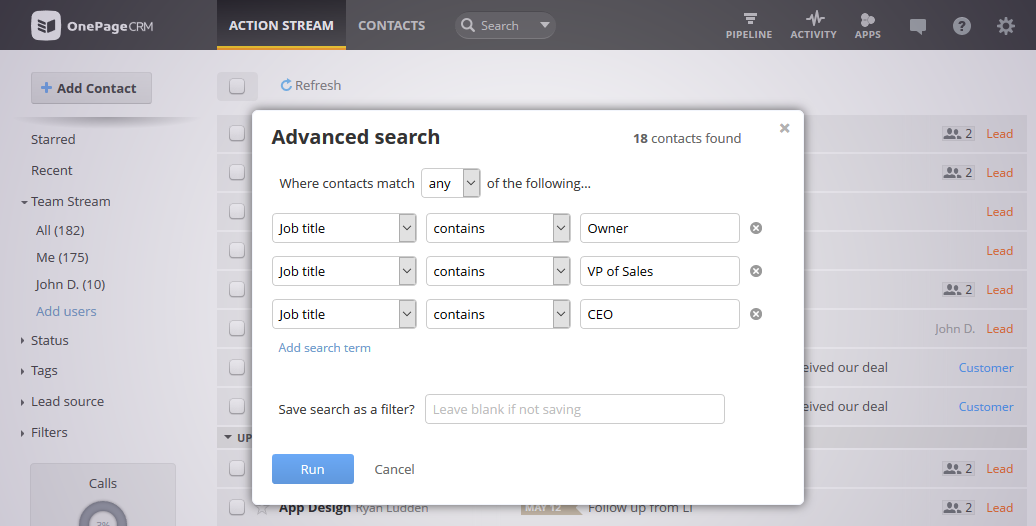
Run an Advanced search to identify C-suite contacts in your CRM:
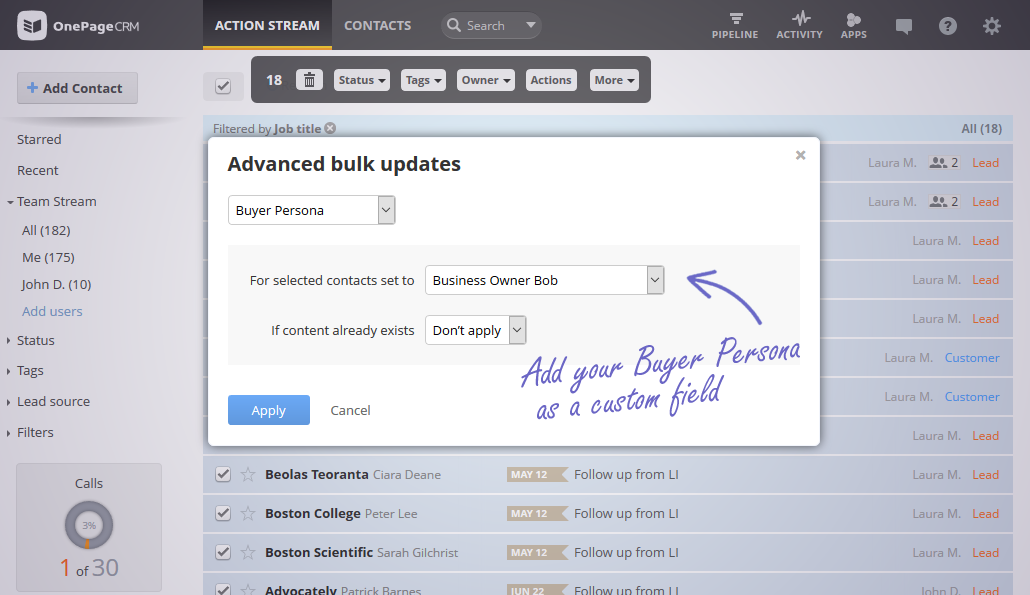
2. Segment your marketing campaigns and onboarding based on your buyer persona
One of the main reasons for using personas is that when you target everyone you actually target no one.
By segmenting your leads by buyer persona, you can customize your message to each segment with custom landing pages, targeted advertising campaigns and email campaigns.
“Marketers have noted a 760% increase in revenue from segmented campaigns.”
If you use an email marketing app like Mailchimp, for contacting your prospects or customers, look at segmenting your email lists by buyer persona.
If you’re a OnePageCRM customer, you can create a segment in Mailchimp right from within the app!
3. Create segments in Mailchimp from Buyer Persona in your CRM
To create a segment for each of your buyer personas in Mailchimp you will first need to create a Tag for each persona in OnePageCRM.
If you have already added your buyer persona as a Custom Field as above, you will simply need to run an Advanced Search for the specific persona and add a corresponding tag.
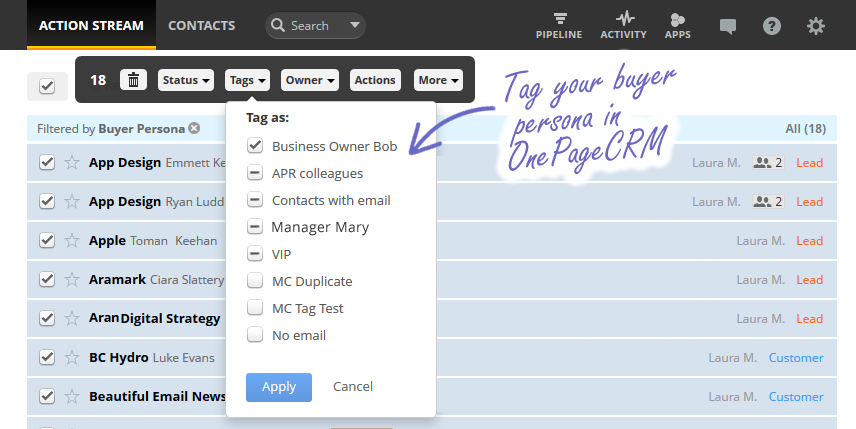
Once you have added a Tag to your buyer persona, you can create your Mailchimp segment, right from within OnePageCRM!
Simply go to the Apps & Integrations page > Mailchimp > Segments > Create Segment.
 Once your buyer persona has been added to Mailchimp you can begin sending tailored marketing campaigns or even customize your onboarding sequence based on the leads’ involvement in the decision-making process.
Once your buyer persona has been added to Mailchimp you can begin sending tailored marketing campaigns or even customize your onboarding sequence based on the leads’ involvement in the decision-making process.

Send targeted marketing campaigns or onboarding sequences to contacts that match your buyer persona.
4. Use your persona to benchmark and set goals
By tracking buyer persona activity in your CRM, you can start to identify patterns and record trends around specific data segments.
For example, you might notice that ‘Business Owner Bob’ converts at a faster rate than ‘Manager Mary’. But, ‘Manager Mary’ requires less onboarding.

As your understanding of the value of each persona grows, you might look at setting targets for your sales teams, by highlighting key personas as high-value leads.
Your buyer persona can act as a preliminary lead score for your SDR.
7 more ways to put your buyer persona to work
- Assign specific persona to your SDRs/Account Executives and allocate leads according to persona.
- Implement persona-specific onboarding for new leads – email marketing, funnel content, number of calls etc.
- Create lookalike audiences of your persona to target across your ad networks.
- Reevaluate and reallocate your ad spend to target your highest-quality leads.
- Audit your current content to align with your persona and write persona-specific blog articles and ebooks.
- Highlight negative persona in your CRM and avoid assigning resources here.
- Take a persona-first approach when devising sales and marketing strategies.








